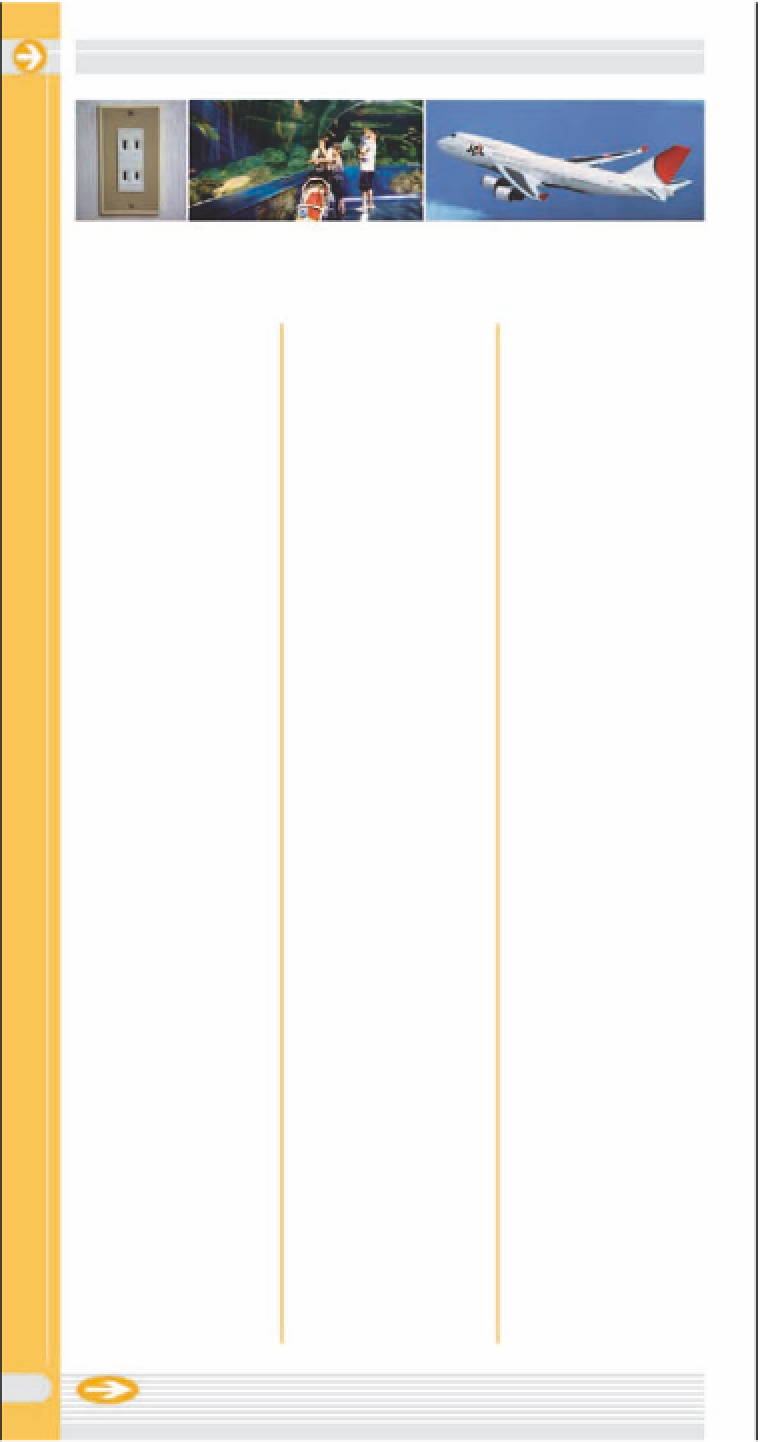Travel Reference
In-Depth Information
Left
Electricity
Center
An aquarium inside a children's park
Right
JAL (Japan Airlines) airplane
Planning Your Trip
!
When to Go
clothing, or better still,
buy some at Tokyo's
discount stores. Casual
but clean is the general
rule for dress in Japan.
Shoes that can be slipped
on and off are essential.
Bring plenty of sun block
in the summer. There is
no need to pack digital or
traditional film, as these
are readily available.
Drugstores are well
stocked for babies.
Restaurants usually
welcome children,
though only large hotels
offer babysitting facilities.
Spring (Apr-May) and
fall (Oct-Nov) are the best
months for outdoor festi-
vals and cultural events.
Pleasantly bearable, win-
ter (Dec-Feb) is a good
time to travel, as is mid-
Aug (O-Bon Festival).
Transportation outside
Tokyo can be crowded
at these times. Golden
Week (Apr 29-May 5) and
the New Year (Dec 28-Jan
4) are major vacations,
during which there is
a stiff rise in flight and
accommodation costs.
*
Time Zone
Tokyo time is nine
hours ahead of GMT
and 14 hours ahead
of US EST. There is no
daylight-savings time.
(
Electricity
%
Passports and
Visas
A temporary 90-day
visitor visa is issued on
arrival to citizens of
Western countries. Visa
requests can be made at
the immigration bureau
at least ten days before
the original visa expires.
The Japan Ministry of
Foreign Affairs has a
website (www.mofa.go.
jp) with a guide to
Japanese visas.
Japan uses the
two-pin type plug
common in Asia and
North America. The
current is 100V AC.
Tokyo and the eastern
part of Japan are on
the 50Hz system.
Adaptors are sold at
airport camera and
electric stores and
Tokyo electric stores.
)
Climate
@
Airlines
JAL (Japan Air Lines),
the national airline, offers
flights to almost all major
destinations in the world.
ANA (All Nippon Airways),
the second-largest carrier,
has a network of inter-
national and domestic
destinations. Ticket prices
are comparable. Most
international flights arrive
at Narita Airport and dom-
estic flights at Haneda.
£
How Long to Stay
^
Language
Crisp winter days can
be pleasant, often with
clear skies. Temperatures
occasionally drop below
zero, but snow is rare.
Spring is generally mild,
with some rainfall in late
April. June to early July
is the rainy season, with
high humidity. Those not
used to extreme humidity
may find the summer
months (Jun-early Sep)
very hot, with recent
temperatures up to 100°F
(39°C). Typhoons may
hit the city in September,
but these are unpre-
dictable. Temperatures
drop in fall, with its
brilliant foliage and
clear skies.
English signage is
excellent, especially in
the subways. The largest
number of English
speakers in Japan are in
Tokyo, but don't expect
fluency from people on
the street. Police officers,
taxi drivers, and store
attendants are more
likely to speak English.
&
Traveling with
Tokyo's sheer scale
and cultural diversity
make it a truly infinite
city. Time and budget
permitting, a stay of up
to two weeks is ideal for
exploring the city. Visitors
planning to also see
other parts of Japan
should allow at least four
or five days for Tokyo.
Children
Tokyo offers countless
children-centered act-
ivities as well as small
parks. Most department
stores have a recreation
area and sometimes
a rooftop play zone.
$
What to Pack
Travel light. The
weather can be change-
able, so bring varied
11 6
Preceding pages
Nightlife in Kabuki-cho, the Ginza



































